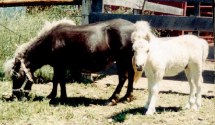When, how, and what else to consider...
WEANING THE NEW FOALS
It is difficult to imagine, but the time to wean babies will be here soon. The rule of thumb is you can wean a foal when it weighs 300 pounds or is three months of age, whichever is latest. Most foals easily weigh 300 pounds by the time they are three months old. [Editorís note: obviously this does not apply to miniature horses, lest some would be nursing until they are 20 years old!]
The routine for weaning starts a few days before the actual weaning date. The foal is usually eating grain either from a creep feeder or alongside the mother. This grain helps alleviate any hunger pangs created by weaning the baby from momís milk. Starting two weeks before weaning, reduce the mareís grain drastically. If the mare has maintained her body condition through the nursing period, the grain can be reduced to a token amount (or about a cup of reduction for the full sized mare). If nursing pulled her weight down, resulting in the mare being thin, feed her one half percent (0.5 %) of her body weight. This is about ½ the grain needed for weight maintenance. For the 1,000 pound mare this would be five pounds per day. Reducing the grain intake has a direct effect on the milk production of the mare. The milk flow will reduce quickly when the grain (and energy) intake drop.
As the mareís milk flow is reduced, the baby will spend more time eating the hay or grass, and will certainly consume more grain. Reducing the mareís milk output will also reduce swelling of the udder after nursing stops. Maintaining a low calory (grain) intake for two weeks before and two weeks after weaning will reduce milk pressure within the udder. Following weaning, the udder may become firm and tender to the touch. It is very important to resist the temptation to milk it out. Removing any milk will only stimulate the udder to produce additional milk to replace it. If the udder should fill unevenly, or if she is sore and walks with reluctance, there could be some inflammation present. If this is the case, the udder should be checked and the appropriate treatment initiated.
Weaning will go much more smoothly if mom can be given a vacation to some distant pasture, out of hearing distance of the baby. Moving the mare away and leaving the baby with friends will speed the process along. These friends can be other weanlings or any pasture mate the with whom foal has recently become acquainted. It needs someone to provide a shoulder to cry on and listen to its sad story.
If the foal has no friends and the mother has to stay within hearing range, the safest way to wean is to provide the foal with a padded stall. The first 48 hours will be traumatic and the baby will try crawling out a knot hole to rejoin its mother who is just on the other side of the wall. Provide grain and good hay, so that hunger is not one of the traumas Jr. must experience.
By now the baby is halter broken, of course. We also suggest the babies be dewormed at least monthly, starting at thirty days. They can be vaccinated when two months old with the first injections of tetanus toxoid, sleeping sickness, influenza, rhinopneumonitis, and strangles. These will need to be boostered in thirty days and at that time the single rabies vaccination can be given.
If there are several horses together or if the pastures have been populated with horses for some time, or if you want to deworm the foals using the best method possible, the daily dewormer added to the creep feed should be considered. The cost is only slightly higher than the monthly deworming, and the effectiveness is much greater. By having the dewormer in the feed each day, the circulating worm larva are killed as soon as they enter the bowel, without the damage done by allowing them to mature and attach to the lining.
CLICK BELOW TO DISPLAY A PRINTER-FRIENDLY COPY OF THIS ARTICLE
Select "Open this file from its current location," if you just want to print it out,
it will open in a simple word processing application, select the print button.
(unless you want to save this article in your computer's memory)

 WeaningTheNewFoals.rtf
WeaningTheNewFoals.rtf